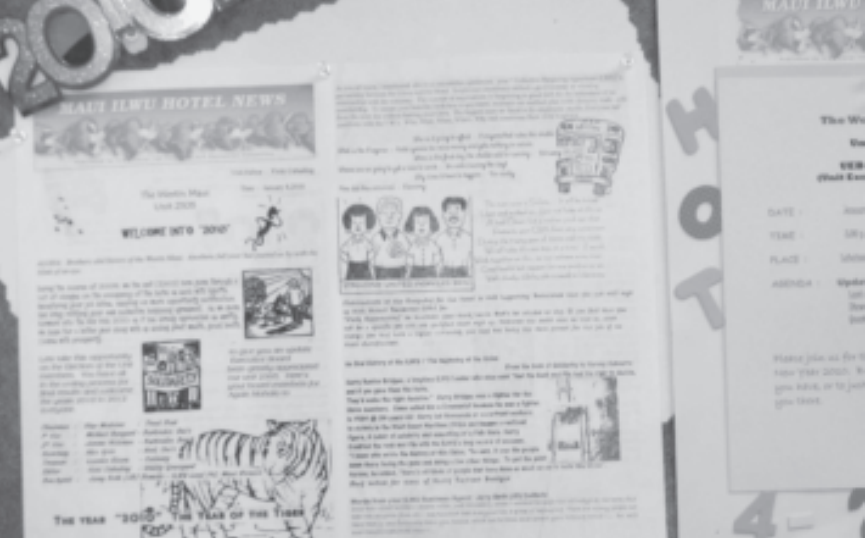
Westin Maui Hotel member Vicky Maliikapu-Cabading prints a bulletin for union members and maintains an outstanding union bulletin board which educates and informs members about the union. Star Medeiros is the Chair of the unit, which has a strong unit structure with active officers and union stewards, including 1st Vice Chair Michael Bunyard, 2nd Vice Chair Jerome

Neizman, Secretary Alex Ajolo, and Treasurer Lourdes Rivera. Because of their strength and solidarity, The Westin Maui members were able to negotiate a new contract with hotel management that increases wages by 13.75% for non-tipped workers and $.60 an hour for tipped workers by the end of the five year contract. Other improvements were made and benefits were maintained.
Competitive Hotel pricing in uncertain times
Hotels that kept their room rates high made more money than competing hotels that cut room rates to boost occupancy. This was the surprising results of a seven-year study by the Cornell University School of Hotel Administration.
The study, conducted by Cathy Enz, Ph.D, Linda Canina, Ph.D., and Mark Lomanno, appears in the June 2009 Cornell Hospitality Report.
Their research analyzed room rates and occupancy levels of over 67,000 hotels in all market segments, from luxury to economy, and during a bad economy from 2001 to 2003 and a good economy between 2004 and 2007.
Many hotel operators believe that lowering room rates during tough economic times will improve their occupancy and revenues by taking customers away from their competitors or by attracting new customers.
Competing hotels are pressured to match or lower their room rates, fearing a loss of business.
The Cornell study focuses on whether this discounting of room rates is a good or bad business strategy and looked at competing hotels in the same area and same market segment—luxury, upscale, midscale, economy, and full service or limited service.
Discounting is bad
Surprisingly, the Cornell study found that hotels that kept their room rates higher did better in revenues per room than their competitors who cut room rates.
This was true for all classes of hotels and in both good and bad economic times.
The results were so consistent that the authors of the study suggest the best strategy to make money is to maintain your room prices up to 10 percent higher than your competitors.
Cutting room rates does increase occupancy, but the increase in occupancy is never high enough to offset the loss of total revenues per room. For example, a hotel that cuts rates by 10 percent would have to see an increase in occupancy of more than 10 percent to make more money. In reality, the increase in occupancy is around 2-4 percent, so the price cutting hotel loses 6-8 percent in revenues.
The competing hotel that kept room prices the same would lose 2-4 percent in occupancy and revenues, but this is much less than the 6-8 percent loss of the price-cutting hotel.
Luxury hotels
In the luxury and upscale market, there was little change in occupancy for hotels that priced their rooms up to 10 percent above their competitors. Occupancy would begin to drop slightly when luxury hotels priced their rooms 10 to 15 percent higher, but the higher room rates more than made up for lower room sales.
The researchers found that luxury hotels that priced their rooms 20-30 percent above their competitors still enjoyed about 13 percent higher total revenues per room then their competitors. The clientele of luxury and upscale hotels are more concerned about guest service than price.
Economy hotels
People who stay in midscale and economy hotels are more sensitive about price. Even in the low end markets, the hotels that kept their room rates 5 percent higher then their competitors still did better in total revenues per room.
Two hotel operators commented that the study matched their experience. In a tough year, one hotel kept their rates the same while their competitors cut room prices. The competitors suffered revenue losses of 13 percent and 33 percent, while the steady hotel lost less than 4 percent.
Another hotel tried reducing rates on Sunday’s which tend to be slow. It made no difference in occupancy, so rather than lose money when the room is sold, the hotel went back to the full Sunday rate.
Download full report
You can find a summary of the report at the following website: http://www.hotelschool.cornell.edu/ research/chr/pubs/reports/abstract15087.html
You can download the full report but you will need to register as a user—its free
Pacific Beach Hotel management appeals, International boycott continues, U.S. labor board vows to pursue justice for workers
HTH Corporation, owners of the Pacific Beach Hotel and Pagoda Restaurant and Hotel, has refused to abide by the remedies ordered by NLRB Judge James. M. Kennedy in a ruling issued on September 30, 2009.
Judge Kennedy found the hotel had seriously violated 15 counts of federal labor law and ordered the hotel to resume negotiations with the ILWU, rehire and pay back wages to seven fired workers, restore all agreements made with the ILWU, pay the union the costs of negotiations, and make a series of other changes.
Hotel appeals decision
Complaining that the NLRB judge and the Hawaii NLRB office were biased against management, HTH Vice-President Robert Minicola appealed the decision to Washington D.C. on October 28, 2009.
The appeal will be heard by the five-member National Labor Relations Board. Currently there are only two members—chairperson Wilma Leibman and Peter Schaumber. President Obama has named Craig Becker, Mark Pearce, and Brian Hayes to the three vacant positions, but the U.S. Senate has not yet confirmed the appointments. Three of the appointees are pro-labor Democrats and two are Republicans.
A senate subcommittee approved the nominees in October 2009, but the full Senate must confirm the appointments.
NLRB seeks court injunction
Tom Cestare, officer in charge of the Hawaii NLRB, estimates it may take six or more months for the Board to act on the appeal. To seek
—continued on page 7
